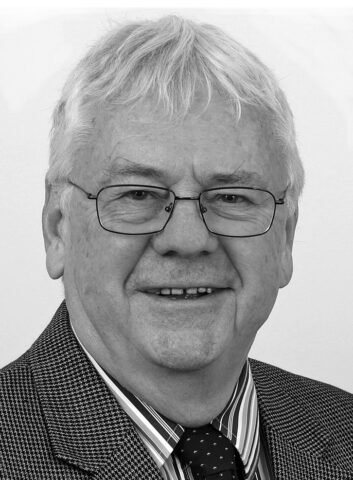Citation
Professor W. James Shuttleworth has brought innovative research, novel scientific thinking, and outstanding leadership to the interface between hydrology and other Earth science disciplines. He has motivated young hydrologists to move beyond established boundaries and brought the hydrologic and atmospheric sciences together to foster the growing field of terrestrial hydrometeorology.
A cornerstone of Jim’s career has been the development of theoretical and experimental methods that underlie the prediction of natural evaporation and are now the foundation for the land-atmosphere models used in numerical weather and climate prediction. He is regarded as the leading international expert on evapotranspiration, and his work led a transformation to physics-based formulations based on the laws of conservation of mass and energy. It is, therefore, no surprise that he was asked to write the chapter on evaporation in the Handbook of Hydrology.
Jim pioneered the modern era of environmental investigations in the Amazon River Basin, where his team developed the capability to measure surface-atmosphere exchanges, ultimately revealing that theories about seasonal variations of evapotranspiration there were wrong. His precedent of combining research with training young scientists is a key aspect of the Large Scale Biosphere-Atmosphere Experiment (LBA).
Jim was arguably the first hydrologist to understand the importance of the hydrology-ecology interface to climate and weather prediction. His papers established a subfield of hydrology devoted to large-scale modeling and prediction. He helped organize and lead large international multidisciplinary research initiatives to improve the representation of surface exchanges in meteorological models and to acquire the data required to test and improve them.
Perhaps most noteworthy, however, is Jim’s leadership in developing terrestrial hydrometeorology as a major discipline of Earth system science, resulting in the world’s first graduate degree program in this subject at the University of Arizona. Characteristic of this leadership, he published the first textbook on the subject, and it is destined to become a classic and basic text for similar academic programs elsewhere.
In summary, Professor Shuttleworth has been an intellectual leader in the field of hydrology for over 40 years and has contributed to broad philosophical perspectives in hydrology, as well as hydrologic understanding and prediction based on careful integration of observations and theory. He has been a prime motivator in vigorous discussions that have been illuminating but never divisive. He is a true gentleman, recognized for his honest commitment to advancing science for the benefit of society, and a consummate example of AGU’s motto “unselfish cooperation in science.”
Response
I am humbled and honored to receive this year’s AGU Horton Medal and sincerely grateful to my nominators, Hoshin Gupta and Dennis Lettenmaier, and to those who wrote in support.
I am lucky to have worked in hydrological science research during 40 years in which it grew hugely in the range of other environmental sciences with which it interacts and in acknowledgment of its importance to humanity. My career was carried forward by this growth.
I am lucky to have worked in two centers of excellence during periods when each experienced the zenith of their success. First, I worked at the UK Institute of Hydrology (IH) when that institution, under Jim McCulloch, was the flag bearer of officer innovation in process studies of surface hydrology. At IH I discovered my passion for understanding natural evaporation and worked with colleagues, including John Gash, Colin Lloyd, Dave McNeil, Chris Moore, Han Dolman, and Howard Oliver, to establish routine application of the eddy correlation method to measure surface exchanges. It is also where, working with Luis Molion, Carlos Nobre, and many, many Brazilian colleagues, we ventured into the then novel hydrometeorological quantification of Amazonian rainforest and where we joined the battle for large-scale quantification of surface-atmosphere exchanges, working with international colleagues, including Jean-Claude Andre, Hans Bolle, Piers Sellers, and Pavel Kabat.
I am lucky because I was next recruited by Soroosh Sorooshian to join the Department of Hydrology and Water Resources (HWR) at the University of Arizona, a unique and massively productive center for hydrological science research. There I work in a stimulating environment with colleagues, including Hoshin Gupta, Tom Maddock, Juan Valdes, Paul Brooks, Shlomo Neuman, and Marek Zreda, to extend studies of surface exchanges with greater emphasis on using remote sensing and on research implemented through talented graduate students, including Paul Houser, Altaf Arain, Russ Scott, Dave Gochis, Omar Sen, Ismail Yucel, and Chawn Harlow, to name just a few. It is where I have been most active in science management, working in National Research Council committees and the International Geosphere-Biosphere Programme, Global Energy and Water Cycle Experiment, and Climate Variability and Predictability programs, and where my interest in using hydrological research to aid policy arose, fostered via the International Association of Hydrological Sciences’ Hydrology for the Environment, Life and Policy (HELP) program and as director of the Semi-Arid Hydrology and Riparian Areas Science and Technology Center.
But I am lucky most because I married my wife, Hazel, who, throughout 50 years of marriage, has been my consistent supporter and who has given me my children, Craig, Matthew, Nicholas, Jonathan, and Amy, and 11 grandchildren and three great-grandchildren!
—W. James “Jim” Shuttleworth, University of Arizona, Tucson, Ariz.
Citation: AGU (2015), W. James “Jim” Shuttleworth receives 2014 Robert E. Horton Medal, Eos, 96, doi:10.1029/2015EO021867.
Text © 2015. The authors. CC BY-NC 3.0
Except where otherwise noted, images are subject to copyright. Any reuse without express permission from the copyright owner is prohibited.

